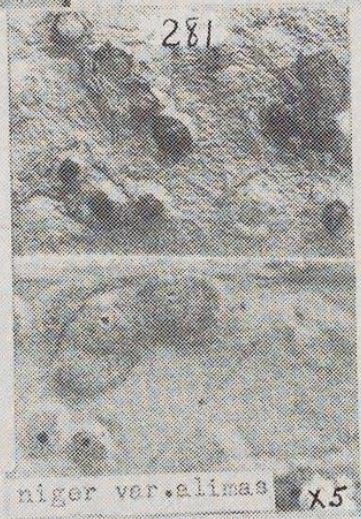Neuroterus bussae (sexgen)
Neuroterus bussae Melika & Nicholls, sp. nov.
Diagnosis. Neuroterus bussae belongs to Kinsey’s subgenus Neuroterus. Only one Neuroterus species north of Mexico, the sexual generation of N. christi Melika & Abrahamson, 1997, is known to induce integral leaf galls on Q. virginiana and Q. geminata. The galls of N. christi are multilocular and integral thickenings of the leaf parenchyma that protrude equally on both sides of the leaf along one side of the midrib, generally with four to six larval cells per gall (Melika & Abrahamson 1997a). In contrast, galls of N. bussae are small, unilocular blister-like leaf galls, that commonly develop all over the leaf lamina.
A taxon with a similar gall was described from Texas on Q. virginiana, N. niger var. alimas Kinsey, 1923, which is one of the five varieties of N. niger Gillette, 1888 described by Kinsey (1923) that were still considered forms of that species by Burks (1979). When the galls of this new species were first encountered, we initially considered that it could be N. niger var. alimas. The holotype of that species was deposited at the USNM and labelled as “Acc.24856”, pink ”N. alimas, female, Holo- Paratype’, ”Q. virginiana”, ”Austin, Tex. 4.16.21., Patterson”; however, when inspected the insect was absent and only the gall was found. One paratype is present, but in a very poor condition, and being male is hard to determine to species. According to Kinsey (1923) this variety induces a sexual generation spring gall, while the other four varieties induce autumn asexual generation galls. Moreover, N. niger var. alimas is the only variety associated with section Virentes oaks while the other four are on Quercus oaks, and as mentioned above no Nearctic cynipid species are shared across the oak sections (Abrahamson et al. 1998a, 2003; Stone et al. 2009). Hence biological information suggests that N. niger var. alimas is a species distinct from N. niger and the other four of Kinsey’s varieties. Kinsey (1923) described N. niger var. alimas based on one female (holotype—lost) and 13 males and gave no detailed morphological description for this variety. Thus, there is no morphological evidence for synonymisation of N. niger var. alimas to N. niger and at the same time it cannot be treated as a valid species so we move it to nomen dubium
Gall. (Figs. 379–380). Blister-like small integral parenchyma galls, visible on both sides of the leaf; on new leaves. Emergence holes typically on upper surface of leaf.
Biology. Only a sexual generation is known, which induces integral leaf galls on Q. virginiana. Galls mature in late March-April, adults emerged immediately after the galls were collected, in March-April.
Distribution. USA, Florida: Morriston, Gainesville, Jacksonville.
”- George Melika, James Nicholls, Warren Abrahamson, Eileen Buss, Graham Stone: (2021) New species of Nearctic oak gall wasps (Hymenoptera: Cynipidae, Cynipini)©







